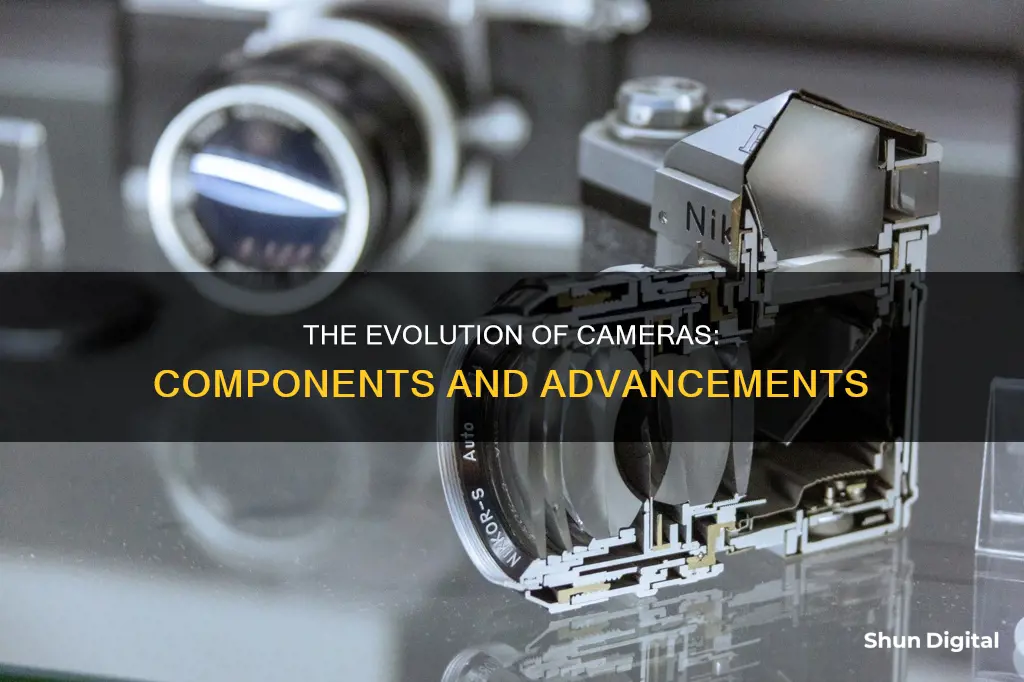
Cameras are made of a combination of materials, including plastic, metal, glass, and rubber. The camera body or chassis is typically made of a polycarbonate compound, which is durable, lightweight, and shock-resistant. The lens is usually made of glass or plastic, and the diaphragm, or aperture, is made of overlapping metal plates. The shutter, which controls the exposure time, can be made of metal leaves or cloth curtains, depending on the type of shutter. In addition to these core components, cameras also contain electronic and mechanical parts, such as circuit boards, batteries, and screws.
| Characteristics | Values |
|---|---|
| Purpose | Capturing and storing images and videos |
| Function | Combination of mechanical components and principles |
| Types | Single-lens reflex (SLR), large-format, medium-format, compact, rangefinder, motion picture, digital, smartphone, etc. |
| Core Components | Lens, diaphragm, shutter, camera body, viewfinder, film/sensor |
| Lens Material | Glass, plastic, or a combination of both |
| Diaphragm Function | Controls amount of light entering the camera |
| Shutter Function | Controls duration of light exposure |
| Camera Body Material | Polycarbonate compound with glass fiber |
| Viewfinder Type | Optical or electronic |
| Image Capture | Light strikes a light-sensitive surface (film or sensor) |
| Film Material | Photographic film (chemical element) |
| Sensor Types | Charge-Coupled Devices (CCDs), Complementary Metal-Oxide-Semiconductor (CMOS) chips |
| Flash | Battery-powered high-voltage discharge through a gas-filled tube |
| Power Source | Battery |
What You'll Learn

Camera lenses are made of glass or plastic
Camera lenses are made of glass, plastic, or a combination of both. Glass lenses offer much better clarity and are generally preferred. Plastic lenses are mostly found in lower-end point-and-shoot cameras, although they are also used in higher-end DSLR lenses. When a lens has an “aspherical" element, it means it has a plastic element.
Lenses are constructed from a series of lens elements—small pieces of glass or plastic—arranged to form an image accurately on the light-sensitive surface. Each element is designed to reduce optical aberrations or distortions, such as chromatic aberration, vignetting, and distortion.
The type of lens material used can also depend on the type of camera. Most small point-and-shoot and mid-range cameras have lenses built into the camera, while digital SLR cameras allow for interchangeable lenses.
It's worth noting that the term "glass" is sometimes used to refer to the camera lens as a whole, regardless of the specific materials used.
Charging Your Fujifilm Waterproof Camera: A Step-by-Step Guide
You may want to see also

Camera bodies are made of polycarbonate compound
Polycarbonate was first discovered in 1898 by German scientist Alfred Einhorn at the University of Munich. However, it was abandoned after 30 years of laboratory research without commercialisation. In 1953, research resumed independently at Bayer in Germany and General Electric (GE) in the US, leading to the first linear polycarbonate being patented by Bayer under the brand name "Makrolon". GE began production under the name Lexan in 1960.
Polycarbonate is a durable material with high impact-resistance, but low scratch-resistance. It has a glass transition temperature of about 147°C (297°F) and softens gradually above this point, flowing at around 155°C (311°F). Due to its chemical properties, it is not conducive to laser-cutting.
In the context of camera bodies, polycarbonate is often used in combination with other materials, such as glass-filled polycarbonate or an aluminium skeleton. This provides a balance of strength, durability, and weight.
Polycarbonate camera bodies offer several advantages, including:
- Impact resistance: Polycarbonate can absorb impact without cracking or breaking, making it ideal for protecting internal circuitry.
- Lightweight: Polycarbonate is lighter than metal, making the camera easier to carry and reducing the shock of dropping.
- Mouldability: Polycarbonate can be easily moulded into various shapes, allowing for ergonomic designs and curved edges that slide in and out of camera bags easily.
- Weather resistance: Polycarbonate is resistant to severe weather conditions and can be used in the construction of weatherproof cameras.
However, there are also some considerations to keep in mind:
- Scratch resistance: Polycarbonate has low scratch resistance and may require additional coatings or treatments for certain applications.
- Brittleness: Over time, polycarbonate can become brittle, especially when exposed to severe impact or ionizing radiation above 25 kGy (kJ/kg).
- UV stability: Standard polycarbonate resins are not suitable for long-term exposure to UV radiation and require UV stabilisers to prevent degradation.
Overall, the use of polycarbonate compounds in camera bodies offers a range of benefits that contribute to the functionality, durability, and aesthetics of modern cameras.
Charging the Wyze Outdoor Camera: How Long Does It Take?
You may want to see also

Cameras have shutters made of metal
There are two main types of camera shutters: electronic and mechanical. Mechanical shutters are further divided into leaf shutters and focal-plane shutters. Leaf shutters are positioned between or just behind the lens components and consist of overlapping metal blades that open and close either by spring action or electronically. The number of blades can be odd, usually 3 or 5, to create a more circular aperture. Focal-plane shutters, on the other hand, are located directly in front of the image plane and consist of a pair of overlapping blinds or curtains that form an adjustable slit or window.
The choice between electronic and mechanical shutters depends on various factors. Electronic shutters are faster and can achieve shorter exposure times. They are also completely silent, which is advantageous for certain types of photography. On the other hand, mechanical shutters offer better flash synchronisation and reduced rolling shutter distortion. Additionally, mechanical shutters provide a more consistent exposure across the sensor due to their two-curtain system.
The development of shutters has evolved from simple manual attachments to integral parts of the camera. Early shutters were often operated manually, with the photographer fitting them to the camera. Over time, shutters became more sophisticated, incorporating springs, rubber bands, and pneumatic mechanisms to control exposure time. Today, modern camera shutters are highly advanced, utilising both mechanical and electronic components to capture precise and high-quality images.
The Craft of Camera Bag Making
You may want to see also

Cameras have an aperture to control light
Cameras have an aperture to control the amount of light that enters the camera. The aperture is an opening or diaphragm in the lens that can be adjusted to be wider or narrower. This adjustment controls how much light reaches the camera's film or sensor, thereby affecting the exposure of the image. A wider aperture, often denoted by a lower f-number (e.g. f/1.4), allows more light to enter, resulting in a brighter image. Conversely, a narrower aperture, represented by a higher f-number (e.g. f/16), lets in less light, making the image darker.
The aperture setting also influences the depth of field in an image, which refers to the amount of the photograph that appears sharp from front to back. A wider aperture results in a shallow depth of field, creating a blurred background with a sharp focus on the subject. This effect is often desired in portrait photography to draw attention to the subject. On the other hand, a narrower aperture yields a greater depth of field, keeping both the foreground and background in focus. Landscape photographers often utilise this effect to capture sharp images from the nearby foreground to the distant horizon.
In addition to its impact on brightness and depth of field, the aperture also influences the quality of the background blur, known as bokeh. The aperture blades contribute to the bokeh effect, and lenses with a higher number of blades tend to produce rounder and more aesthetically pleasing bokeh.
The aperture is one of the critical components in photography, alongside shutter speed and ISO, that photographers can manipulate to achieve their desired results. By adjusting the aperture, photographers can control the amount of light, the depth of field, and the overall exposure of their images.
Troubleshooting Camera Battery Issues: A Quick Fix Guide
You may want to see also

Cameras are made of recyclable materials
Cameras are made of a variety of materials, many of which are recyclable. The most common materials used in camera construction are plastic and metal, which form the casing, lens housing, and various other components. Glass is also used in lens construction and other optical elements, while rubber is employed for specific parts like gaskets and grips. Circuit boards, containing precious metals such as gold, silver, and palladium, are integral to the camera's electronic functions.
The recyclability of these materials is essential for reducing electronic waste, a growing environmental concern. By recycling cameras, we can divert them from landfills, where they contribute to soil and water contamination due to hazardous substances like lead, mercury, and cadmium. Proper recycling allows for the reuse and repurposing of camera parts, prolonging their usable life and conserving resources.
The process of recycling cameras typically involves dismantling them into their constituent parts. The plastic, metal, glass, and rubber components are separated and sorted into different material categories for further processing. This enables the production of new products, including new cameras, toys, and furniture.
Camera recycling offers multiple benefits beyond environmental protection. It helps reduce the carbon footprint associated with electronic waste and supports organizations dedicated to environmental causes. Additionally, it provides economic opportunities and ensures that valuable materials from cameras are not wasted, reducing the need for mining and extracting new metals.
The camera chassis or body, for example, is often made of a polycarbonate compound containing glass fiber. This durable, lightweight, and shock-resistant material can be recycled and reused in the manufacturing process. Camera lenses, whether made of glass or plastic, can also be recycled, finding new applications in optics or other industries.
Understanding Camera Scene Modes: Unleashing Creative Photography
You may want to see also
Frequently asked questions
Most cameras are made of plastic and metal materials, with other components made of glass, rubber, and electronic circuit boards. The camera chassis or body is usually made of a polycarbonate compound containing 10-20% glass fiber.
Camera lenses are typically made from high-quality glass. They can also be made of plastic or a combination of both.
Camera bodies are usually made of a polycarbonate compound containing glass fiber. This makes the body durable, lightweight, shock-resistant, and tolerant of humidity and temperature changes.







